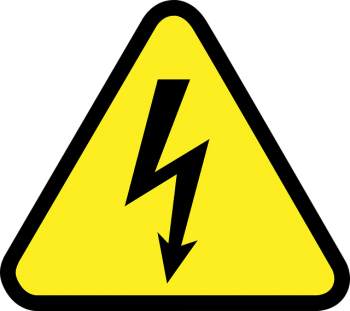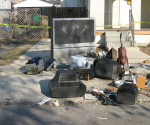Static Eliminators: Why They are Necessary and How They Work
There are very few people who haven’t experienced a jolt of static electricity. For example, if you get up in the morning, wearing socks, and then pace around the room on your carpet frantically looking for the things you’ll need for the day, then touch a doorknob to go into another room, don’t be surprised if you experience a nice little static electricity shock.
Static electricity is encountered because everything is made up of atoms, which have among other properties, electrical charges built up from either positive or negative protons and electrons. When you rub your socks on a carpet, you rub electrons off the carpeting, giving your body a temporary, negative charge. Then when you touch the doorknob and feel a slight spark due to the negatively charged electrons jumping from your body to the doorknob.
Static electricity can cause objects to repel against one another or attract one another. For example, socks may stick together in a clothes dryer because one sock has a positive charge, and the other has a negative charge. Much like putting two opposite ends of a magnet.
On the other hand, people wearing hats, particularly in the wintertime, have the experience of hat discharging minute amounts of static electricity, resulting in the charged hairs temporarily repelling against each other, causing the hairs to fritz and fly away from each other.
Static electricity shock can be measured in a measurement known as millijoules. It takes about 1 millijoule for a static shock to be noticed, and 10-30 millijoules for a shock to make you flinch. Meanwhile, it will take about 1350 millijoules to kill you.
Consequently, you are in little danger from scampering across your carpet in socks, however, when it comes to electronic components in computers, cellphones, and electronic devices, and also various gasses are very much influenced by static electricity.

photo David Peña via pixabay
Flammables and Static Electricity Can Lead to Disasters
It may not reach the major news headlines, but there are nearly 300 accidents charged by flammables exploding due to a build-up in static electricity each year. Truckers, transporting flammables, bulk storage plants, and rail tankers, vacuum trucks for clearing combustibles, and terminal operations all are in danger of static electricity explosions, big and little. To counter this, the vast majority of trucks, storage plants, and terminal operations are equipped with special static electricity bonding systems that eliminate the reduction of static electricity. Tanker drivers, in particular, often where static protection gloves throughout transfer operations, and are trained in how to avoid the build-up of static electricity.
The vast majority of the concerns about static electricity, however, relate to the manufacturing of computers, cellular phones, medical devices, and pretty much anything computer-like, from aircraft to spacecraft.
Electronic Components and Static Electricity
What makes electronic components so vulnerable to static electricity is that transistors and other electronic components are also extremely vulnerable to the effects of static electricity.
While a human, for example, may notice a static electricity shock of one millijoule, it may take less than .2 millijoules to completely destroy a major component of an electronic device. Or to put it more simply, you may not notice a thing when a small, Electronic Static Discharge takes place, but the electronics you are working on at the factory sure will.
Electronic Components that are particularly vulnerable include:
- MOSFET transistors, used to make integrated circuits
- CMOS Integrated Chips
- Computer Cards such as expansion cards or accessory cards
- Transistor logic integrated chips (TTL)
- Laser diodes
- Blue light emitting diodes
- Precision resistors
The main problem with electrostatic discharges is not that they can destroy chips and lead to outright electronic failure, but the worst case is that they cause latent damage, which may structurally weaken glues or bonding agents, such that their effect is not noticed until they have significantly left the factory.

photo/ Michael Jarmoluk via pixabay.com
One design and engineering magazine, RS Online estimated it costs around $8 to replace an ESD Damaged part before it goes into the computer system, but between $800 to $8,000 if it is installed in the system, and overall up to $80,000 or more in overall cost to the company if the problem is systemic. RSI also estimates that the product loses range between 8 and 33 percent due to ESD problems.
Static eliminators to the rescue
To combat the potential for enormous losses to ESD, most direct manufacturers of computers, cellphones, televisions, and high-end medical devices make their employees wear static eliminators when working around the equipment.
Most people have heard of wrist band attached to a wire which grounds the workbench area, and the principle is simple, by adding a bit of electricity to the band, which is commonly exposed at the wrist, your body becomes completely grounded when working with computer parts.
Another type of static reduction system is called an anti-static power bar. Here the air is charged with minute molecules, which are then attracted by any passing item to the power bar, noticeably the worker, and as a result, the surroundings are neutralized and dust and other items will no longer be attracted to sensitive machinery and parts.
Manufacturers of computer parts often use power bars, require their workers to wear leather shoes, stand on rubber mats, and wear cotton gloves. If a part is particularly sensitive, a manufacturer may even pump in a fine mist of water to humidify that section of the plant, as the higher the humidity, the less static electricity is built up.
Problems with Static Electricity are Getting Worse
You would think that the problem of static electricity would be an easy thing to fix, but the plain fact is, they are getting worse, not better. For example, the availability of low-sulfur diesel fuel has made fires from static sparks much more common. And computer parts, are getting micro-thin, and hundreds of times more sensitive, making them, unfortunately, more sensitive to EDS problems than even five years ago, so the battle to combat EDS is ever-present.
Author: Brenda Vollman














